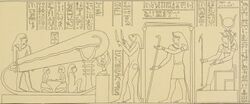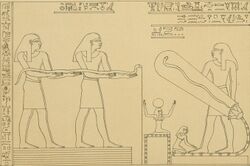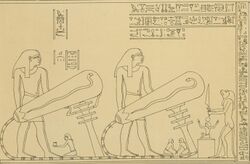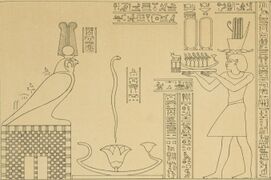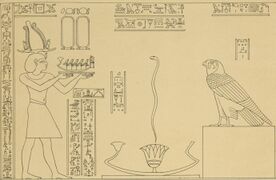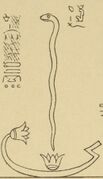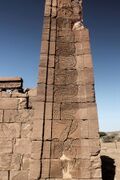Unsolved:Dendera light
| Dendera light | |
|---|---|
 |
The Dendera light is a motif in the Hathor temple at Dendera in Egypt. It depicts the Egyptian creation myth, and the text surrounding the pieces confirm this.
The temple contains several reliefs depicting Harsomtus, in the form of a snake, emerging from a lotus flower which is usually attached to the bow of a barge. The so-called dendera light is a variation of this motif, showing Harsomtus in an oval container called hn, which might represent the womb of Nut.[1][2]
Sometimes a djed pillar supports the snake or the container. A closely related motif is "god resting on the lotus flower".
Depictions and text
Each of the three objects consists of two reliefs. One half (a) of each pair is in south crypt 1-C (crypte 4), the other half (b) in room G (chambre V) of the temple.[1]
| Object
(location) |
Text | Relief |
|---|---|---|
| Object 1(a)
(Crypt 1-C, south wall) |
Speaking the words of Harsomtus, the great God, who dwells in Dendera, who is in the arms of the first in the night-barge, sublime snake, whose Chentj-statue carries Heh, whose crew carries in holiness his perfection, whose Ba caused Hathor to appear in the sky, whose figure is revered by his followers, who is unique, encircled by his forehead-snake, with countless names on the top of Chui-en-hesen, the symbol of power of Re in the land of Atum (Dendera), the father of the Gods, who created everything.
Gold his metal, height: four handbreadths |
File:Denderah. Grand temple. Crypte no. 4 (NYPL b16461786-1548061) (lower) (cropped).tiff |
| Object 2(a)
(Crypt 1-C, south wall) |
Speaking the words of Harsomtus, the great God, who dwells in Dendera, the living Ba in the lotus flower of the day-barge, whose perfection is carried by the two arms of the djed-pillar as his Seschemu-image, while the Kas on their knees bend their arms.
Gold and all precious stones, height: three handbreadths |
File:Denderah. Grand temple. Crypte no. 4 (NYPL b16461786-1548061) (lower) (cropped).tiff |
| Object 3(a)
(Crypt 1-C, north wall) |
Speaking the words of Harsomtus, the great God, who dwells in Dendera, who emerges out of the lotus flower as a living Ba, whose completeness is elevated by the Kematju-images of his Ka, whose Seschemu-image is revered by the crew of the day-barge, whose body is carried by the djed-pillar, underneath his Seschemu-image is the Primal and whose majesty is carried by the companions of his Ka.
Gold, height: one cubit |
|
| Object 1(b)
(Room G, south wall) |
Harsomtus in the hn-container of the night-barge that contains four figures. The figure of heh is in front of him, whereas this flower is behind him, the water beneath him.
Gold his metal, height: four handbreadths. |
|
| Object 2(b)
(Room G, north wall) |
Harsomtus on his barge
Gold and all precious stones, height: three handbreadths |
|
| Object 3(b)
(Room G, north wall) |
Harsomtus of Upper- and Lower Egypt, the Sata-snake, that emerges from the flower, which contains the hn-container, who is flanked by four figures with human faces, under his head the figure of Heh on the Serech on the bow of his barge. The Juf-monkey with the face of a toad, armed with knives, is in front of him, as are the two figures that carry the front part of this flower. |
Similar motifs
Fringe interpretation
In contrast to the mainstream interpretation, a fringe theory proposes that the reliefs depict Ancient Egyptian technology, based on comparison to similar modern devices (such as a Cathode-ray tube, Geissler tubes, Crookes tubes, and arc lamps). Norman Lockyer's passing reference to a colleague's humorous suggestion that electric lamps would explain the absence of lampblack deposits in the tombs has sometimes been forwarded as an argument supporting this particular interpretation (another argument being made is the use of a system of reflective mirrors).[3]
Proponents of this interpretation have also used a text stating that "high poles covered with copper plates were erected to break the storms[Note 1] coming from on high" to argue this,[4][5] but Bolko Stern has written in detail explaining why the copper-covered tops of poles (which were lower than the associated pylons) do not relate to electricity or lightning, pointing out that no evidence of anything used to manipulate electricity had been found in Egypt and that this was a magical and not a technical installation.[6]
Archaeologist and debunker Kenneth Feder argued that if ancient Egyptians really had such advanced technology, some light bulb remains (glass shards, metal sockets, filaments...) should have been discovered during archaeological excavations. By applying Occam's razor, he instead highlighted the feasibility of the aforementioned reflective mirrors system, and also that the notion of adding salt to torches to minimize lampblack was well known by ancient Egyptians.[7]
See also
- Egyptian mythology
References
- ↑ 1.0 1.1 Waitkus 2002.
- ↑ Waitkus 1997.
- ↑ Lockyer 1894, p. 180-181.
- ↑ Kolbe 1908, p. 391.
- ↑ Dümichen 1877, p. 13.
- ↑ Stern 1896, p. 106-108.
- ↑ Feder 2014, p. 225–227.
Notes
- ↑ storms mistyped as stones in source
Sources cited
- Dümichen, Johannes (1877). Baugeschichte des Denderatempels und Beschreibung der einzelnen Theile des Bauwerkes nach den an seinen Mauern befindlichen Inschriften. https://digi.ub.uni-heidelberg.de/diglit/duemichen1877a.
- Feder, Kenneth H. (2014). Frauds, Myths, and Mysteries: Science and Pseudoscience in Archaeology. New York: McGraw-Hill. ISBN 978-0-07-803507-4.
- Kolbe, Bruno (1908). An Introduction to Electricity. Kegan Paul, Trench , Trübner. https://archive.org/details/anintroductiont00trgoog/.
- Lockyer, Norman (1894) (in en). The Dawn of Astronomy. ISBN 9780262120142. https://archive.org/details/dawnofastronomys00lockuoft/. Retrieved 2020-10-06.
- Mariette, Auguste (1870) (in fr). Dendérah: description générale du grand temple de cette ville. https://digi.ub.uni-heidelberg.de/diglit/mariette1870ga.
- Stern, Bolko (1896) (in de). Ägyptische Kulturgeschichte. Reprint-Verlag-Leipzig. ISBN 978-3826219085.
- Waitkus, Wolfgang (1997) (in de). Die Texte in den unteren Krypten des Hathortempels von Dendera: ihre Aussagen zur Funktion und Bedeutung dieser Räume. ISBN 3-8053-2322-0.
- Waitkus, Wolfgang (2002). "Die Geburt des Harsomtus aus der Blüte — Zur Bedeutung und Funktion einiger Kultgegenstände des Tempels von Dendera" (in de). Studien zur Altägyptischen Kultur 30: 373–394. https://www.jstor.org/stable/25152877.
External links
- "The Dendera Reliefs, Catchpenny Mysteries". http://www.catchpenny.org/dendera.html.
- Dörnenburg, Frank (2004). "Electric lights in Egypt?". http://doernenburg.alien.de/alternativ/dendera/dend00_e.php.
- "Awful Archaeology Ep. 5: The Dendera Light". https://youtube.com/watch?v=2OOrlhtdONE.
- "Debunking the Dendera "Light Bulb"". 3 October 2019. https://anthropology.msu.edu/anp364-fs19/2019/10/02/debunking-the-dendera-light-bulb/.
- "Dendera Temple Crypt". http://users.iafrica.com/g/gr/grenvill/denderah.htm.
[ ⚑ ] 26°08′30″N 32°40′13″E / 26.141611°N 32.670139°E
el:Δένδερα#Ανάγλυφο στο ναό της Αθώρ
 |
